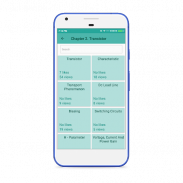






Electronics - I

توضیحات Electronics - I
It is swipe base design for bio technology students to learn basics of electronics . It almost cover important topics with their graphics chapter wise which are given below
Chapter 1. Semi conductor diodes
1. Introduction to circuit elements R,L,C and their characteristics
2. current sources controlled
3. uncontrolled sources KCL and KVL analysis
4. Nodal & mesh analysis
5. analysis of magnetically coupled circuits
6. Transients in RL Circuits
7. Transients in RC Circuits
8. Concept of phasor & vector
9. Network topology
10. concept of Network graph
11. Tree and Tree branch & link
12. Incidence matrix
13. dual networks
14. Dot convention
15. tuned circuits
16. Series & parallel resonance
Chapter 2. Transistor
1. Transistor
2. Characteristic
3. Transport phenomenon
4. DC load line
5. Biasing
6. Switching Circuits
7. h - Parameter
8. Voltage, Current and Power Gain
9. JEFT
10. Transfer characteristics MOSFET
11. Types of MOSFET
12. RC Coupled Amplifier
13. Noise in BJT
Chapter 3. Feedback amplifiers & oscillators
1. Negative and positive feedback
2. Gain and sensitivity
3. BANDWIDTH
4. Types of feedback
5. Oscillator
6. Types of oscillator and application
7. UJT characteristics and application
8. Multi vibrator circuits and their applications.
Chapter 4. Power amplifier and Regulators Classification
1. Types of power amplifier circuits
2. Amplifier Applications
3. Complementary symmetry circuits
4. Push pull amplifier
5. Crossover Distortion
6. Biasing of power amplifier
7. Heat sink
8. Voltage regulator
9. Current initiating circuits
10. Adjustable Voltage Regulator
11. 3 terminal positive series regulators
12. Dual IC power supply SMPS
Chapter 5. Design and application of electronic circuits
1. Design and application of passive filter
2. Designing of clipper and clamper
3. Circuit
4. Designing of power amplifiers
5. Feedback amplifier
6. Oscillators and DC coupled amplifier circuits
7. Designing of multivibrators circuits.
</div> <div jsname="WJz9Hc" style="display:none">Het is swipe basisontwerp voor bio-technologie studenten naar de basis van de elektronica te leren. Het beslaan bijna belangrijke thema's met hun graphics hoofdstuk wijze die hieronder worden gegeven
Hoofdstuk 1. Semi conductor diodes
1. Inleiding tot circuitelementen R, L, C en kenmerken
2. stroombronnen gecontroleerde
3. ongecontroleerde bronnen KCL en KVL analyse
4. Nodal & mesh analyse
5. analyse van magnetisch gekoppelde circuits
6. Transiënten in RL Circuits
7. Transiënten in RC Circuits
8. Concept phasor & vector
9. Netwerktypologie
10. begrip netwerkgrafiek
11. Boom en tak van de boom & koppeling
12. incidentiematrix
13. dual-netwerken
14. Dot conventie
15. afgestemde kringen
16. Serie & parallel resonantie
Hoofdstuk 2. Transistor
1. Transistor
2. Kenmerk
3. Transport fenomeen
4. DC-belasting lijn
5. Biasing
6. Switching Circuits
7. h - Parameter
8. spanning, stroom en vermogensversterking
9. JEFT
10. Overdracht kenmerken MOSFET
11. Soorten MOSFET
12. RC Gekoppeld Amplifier
13. Lawaai in BJT
Hoofdstuk 3. Terugkoppeling versterkers en oscillatoren
1. Negatieve en positieve feedback
2. Gain en gevoeligheid
3. BANDWIDTH
4. Soorten feedback
5. Oscillator
6. Soorten oscillator en toepassing
7. UJT kenmerken en toepassing
8. Multi vibrator circuits en hun toepassingen.
Hoofdstuk 4. power versterker en Regulators Classificatie
1. Soorten eindversterker circuits
2. Versterker Toepassingen
3. Aanvullende symmetrie circuits
4. push-pull versterker
5. Crossover Distortion
6. Vertekenende van eindversterker
7. Koellichaam
8. Voltage regulator
9. Huidige initiërende circuits
10. Adjustable Voltage Regulator
11. 3 terminal positieve reeks regelgevers
12. Dubbele IC stroomvoorziening SMPS
Hoofdstuk 5. Ontwerp en toepassing van elektronische schakelingen
1. Ontwerp en toepassing van passieve filter
2. Het ontwerpen van clipper en klem
3. Circuit
4. Het ontwerpen van eindversterkers
5. Terugkoppeling versterker
6. oscillators en DC gekoppeld versterkercircuits
7. ontwerpen van multivibratoren circuits.</div> <div class="show-more-end">


























